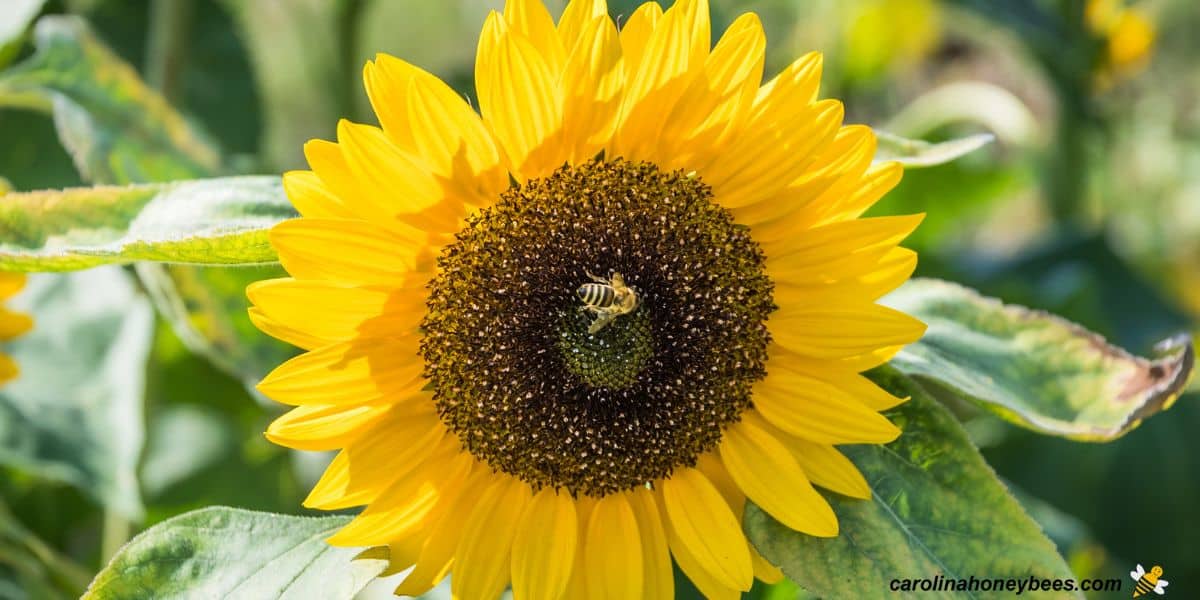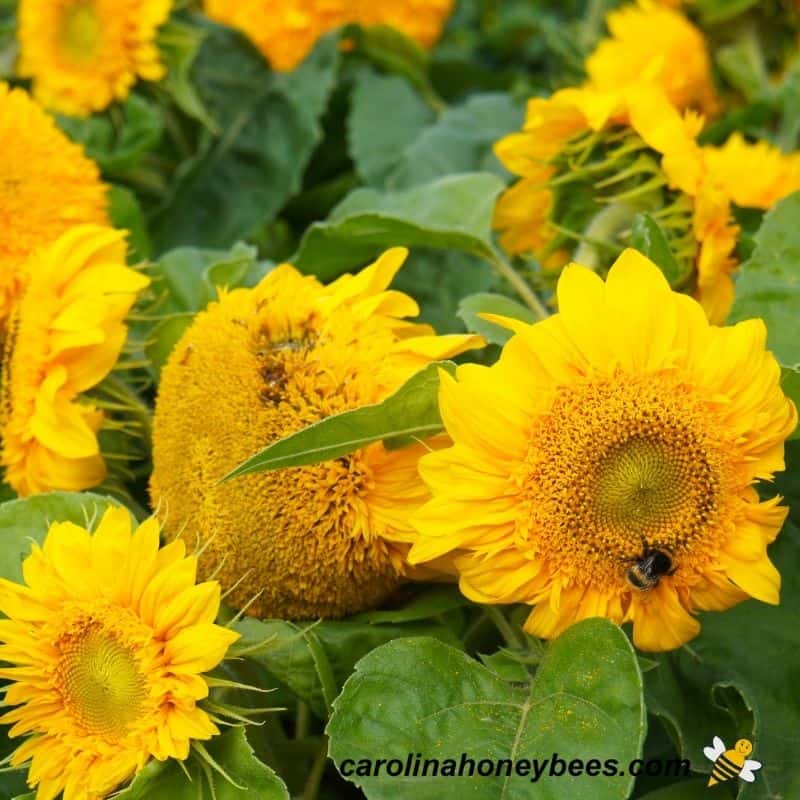Why Sunflowers Matter to Bees
More than providing beautiful, cheery flowers, sunflowers are important to bees as a food source. Large open-faced blossoms can provide ample nectar and pollen to hungry pollinators. But not all sunflowers are equally helpful. Some hybrids are bred to be pollen-less for floral arrangements. In this guide, you will learn how to choose the best sunflowers for bees and other pollinators to grow in your garden.

As a long-term beekeeper, I am always on the watch for nectar-rich flowers for bees. If I am going to plant something – it is a plus to provide the colonies with some food too. Sunflowers are one of the easiest to grow – as long as, you have a location that gets some sun.
Are All Sunflowers Beneficial to Pollinators?
While sunflowers, as a group, are considered pollinator friendly, their value to bees varies by type. The key factors are nectar production, pollen availability and flower accessibility.
Both nectar and pollen are vital foods that food bees eat.
Sweet liquid nectar is secreted by flowers to attract insects for pollination in order to produce seed. Honey bees make honey from plant nectar and store it in the hive for an energy source.
Honey bees use pollen as a protein source to raise young. From the view point of the bees, pollination occurs accidentally.
Pollen is inadvertently moved from one flower to another as the bees collect things they need.
This post may contain affiliate links. As an Amazon Associate, I earn from qualifying purchases. Please read my disclosure.

Top Sunflower Varieties for Honey Bees
Here are some of the top sunflowers varieties that gardeners claim are a favorite of bees (especially honey bees) . Read the label for each type to determine their size and requirements.
- Lemon Queen
- Mammoth Grey Stripe
- Black Russia
- Giant White Seeded
- Henry Wilde
- Autumn Beauty
- Chocolate Cherry
- Evening Sun
- Sonja
- Red Sun
- Maximillian – Requires cold temps to germinate (plant in Winter or keep in frig)!
- Velvet Queen
- Teddy Bear Sungold
The small teddy bear variety (Sungold) provides some pollen if you only have a small space in your bee friendly garden.
Try to combine more than 1 sunflower variety for longer bloom time and include some other perennials bees like in nearby areas. These will establish your beds and leave room for annuals to replace each Spring.
Open-Pollinated vs Pollen-Free
If you want to plant sunflowers for bees, it’s important to understand the difference between open-pollinated and pollen-free (or sterile hybrid) sunflower varieties.
Open-pollinated sunflowers are varieties that reproduce naturally—by wind, insects, or self-pollination—without human interference in their pollination process.
Pollen-free sunflowers are hybrids that are created for the floral industry. They are ideal for cut flower arrangements where minimizing pollen mess is important.
Also, pollen-less cultivars are appealing to gardeners wanting to avoid the mess of pollen. And, it is a matter of serious allergies for some people.
These special hybrids will look great in your garden but they are not beneficial to bees. Read the seed label carefully – as most of these plants will be clearly marked on the retail package.
Sunflower Pollen Benefits
A study published in 2018, suggests that pollen from sunflowers may actually provide some special benefits for honey bees. Other mono-floral pollens did not show the same results of protecting (Apis mellifera) from bee pathogens.
We know for a fact that having a diverse diet is good for insects. Adding a couple of sunflower varieties to the bee garden can’t hurt.

Variety- Sizes and Space
Once you have made the decision to include a few sunflowers in your garden, consider the following recommendations in terms of size. Most sunflowers get tall but not all do.
You do not have to have a large space to grow sunflowers because they come in many varieties beyond the common sunflower (Helianthus annuus). However, many do get very tall-so keep that in mind.
A mix of several different ones adds beauty to the garden and food for pollinators too. In general, sunflowers are divided into 3 groups: Giant, Dwarf and Colorful.
Giant
Giant sunflowers are the most common variety. It is what most people image when they think of sunflowers. They tend to grow tall – perhaps reaching 10-12 feet or more.
They can actually be planted in a way to create a sunflower forest of the stalks. It is a good idea to provide some support by growing in a bunch (patch) or along a fence or other barrier.
Giant sunflowers are easy to start from seed, grow quickly and are an impressive choice for gardening with kids. I often use them in my air-dry seed bombs projects.
Dwarf
Dwarf Sunflowers are those that reach a smaller stature. Tending to be under 4 feet tall, dwarfs normally have a slightly smaller bloom. They are a good choice for smaller spaces and do not require staking.
Some of the smaller types can be grown in large pots or container gardens for bees and other pollinators. But, be sure to check the seed package to make sure they are bee friendly.
Colorful
Colorful sunflowers are mostly newer hybrids. They are grown for their unique color combination. Having the same flower style as traditional sunflowers, they come in a variety of unusual colors. Pale yellow or white is popular, as well as, pink or deep red.
Lemon Queen Sunflowers & Honey Bees
As a standout on the list, we must acknowledge the most popular sunflower grown for bees -Lemon Queen. With large pale petals and dark centers, this flower is magnificent in any garden.
They are also bee magnets and attract many insects including native bees looking for pollen and nectar. Grab some seeds and participate in The Great Sunflower Project.

Care for Your Sunflower Bee Garden
With the word “sun” in the name, you must know that this is not a shade plant. Sunflowers need sun and lots of it. Giving your flowers at least 8 hours of sun each day is the very best location.
Sunflowers do best in light, non-compacted soil. Their roots like to spread out. Heavy clay soil will not produce the best plant. While they appreciate slightly acidic soil, they can do well in alkaline soil too.
These plants like warm temperatures. Heat is good. It is common for bees to continue visiting sunflowers through late Summer and well into Fall.
Even though they can stand drought conditions once established, sunflowers can be heavy feeders. Working organic material in the soil is a great way to encourage them as is using liquid fertilizer.
Especially for the taller varieties, you may need to consider some type of support. Those large flower heads can make the plant “top heavy” especially in windy weather.
Planting them in a group also helps them provide support for each other. Avoid pesticide use on the flower heads, you do not want to poison visiting pollinators. Read labels and understand the dangers of the effects of pesticides on bees.
Start From Seeds
The most common way to grow sunflowers for bees is to start with seeds – always try for organic as they will not have a pesticide covering.
Seeds can be started indoors in peat pots 2-3 weeks before your Spring planting date. Then planted outside “pot and all” before they get too large. Plant your sunflower seedlings – or direct seed- after all danger of frost is over.
FAQs
Sunflowers are very attractive to bees and other pollinators. Choose open-pollinated varieties that provide pollen and nectar.
The symbiotic relationship between sunflowers and bees is one of both parties benefitting from the partnership. The bee gets food and accidentally provides pollination for the plant to produce seed.
Yes, bees can make sunflower honey but it is not commonly available as it requires large fields of plants in bloom and beehive in place at the right time.
Final Thoughts
When growing sunflowers for bees, you get a bonus. Seed produced will be a good food source for birds or other wildlife benefiting all pollinators in your area. It is a wonderful relationship: bees help flowers by providing pollination and the plants give food to the bees. And, we get to enjoy the beautiful blooms.
Additional Resources:


